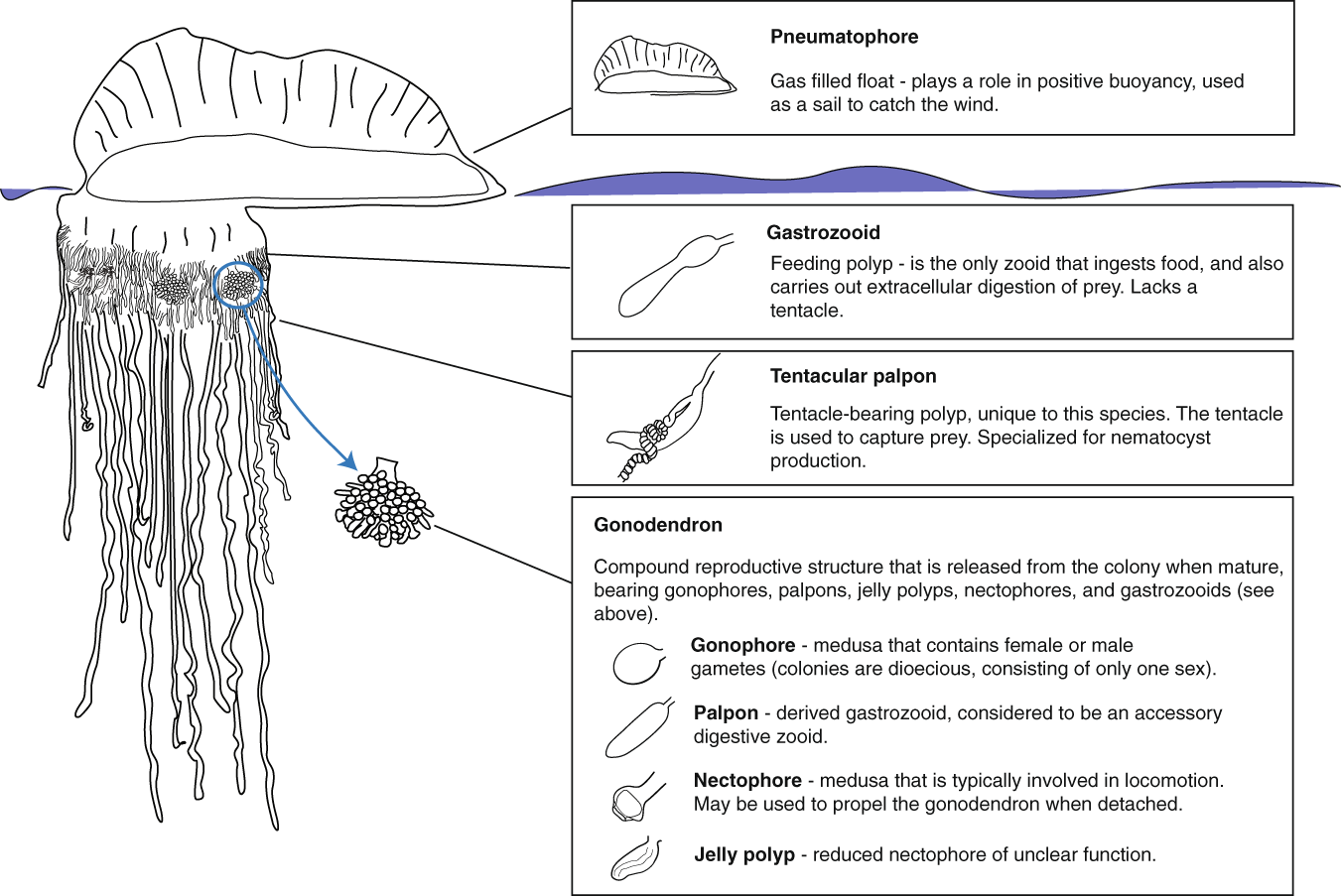Beauty is pain: a famous saying that wonderfully describes the next specimen on this list. I’m sure you have seen or at least heard of the Portuguese man o’ war. With its vibrant coloring and strangely long tentacles, it is certainly hard to miss. This creature (not actually a creature which I will soon elaborate on) is greatly misunderstood. Let’s dive into it.

Calling the Portuguese man o’ war a creature would be misleading, for it is actually a colonial organism, which means it is composed of numerous individual organisms with different functions. The man o’ war consists of as many as seven of these organisms, called zooids, that all depend on each other.
One zooid is the gas-filled sac that keeps it afloat at the surface of the water. Another zooid is the tentacles that help the man o’ war hunt for prey. The other zooids aid in digestion and reproduction.
Although the man o’ war is widely believed to be a type of jellyfish due to its appearance, it is not. It instead belongs to the Hydrozoa family, which are small, predatory animals that live in salt water and are often colonial.

Have you ever been stung by a jellyfish before? Depending on the type of jellyfish, it probably caused a few hours of pain and irritation, but was overall not unbearable and mainly just annoying. A man o’ war’s sting, on the other hand, is described as unbearable.
If you are stung by a Portuguese man o’ war, you will immediately feel an intense burning pain on your body. The tentacles will leave stringy, red welts on the skin that can last hours. You can also develop a rash that can last for up to six weeks after the sting.
Additionally, like some jellyfish, the man o’ war can still sting you after it dies and washes to shore. Although its sting is rarely lethal, you will definitely never forget the feeling of being stung by this lovely colony. Do not be tricked by its dazzling appearance. The man o’ war is a rose, and the tentacles are its razor-sharp thorns.

Can you believe this militia of a marine specimen also has predators? There’s always a bigger fish, I guess.
The blanket octopus is one of man o’ war’s predators. Sometimes these octopi will attach the tentacles of defeated man o’ wars to its suckers, using it as a weapon against their prey and a defensive mechanism against their predators. If you can’t beat ’em, join ’em.
The loggerhead turtle is another one of the man o’ war’s predators. Turtles have very thick skin and tongues, rendering them immune to stings. However, because plastic bags look so similar to the flotation zooid on the man o’ war, turtles will often get confused and try to eat plastic bags floating on the ocean’s surface. The man o’ war arguably benefits from plastic pollution in the ocean? That’s a first.

With its unique characteristic of being a colony, its brutal sting, and its unexpected vulnerability, the man o’ war is quite the alluring and mysterious inhabitant of the ocean. Through protecting its ecosystem and admiring from a distance, we can peacefully coexist with this fascinating being and continue to observe its interesting behaviors. So, next time you come across a Portuguese man o’ war, bask in its beautiful colors, and for the love of God, do not touch it.
That’s super interesting. I had heard about the man o’ war before, as it is well known for it’s horrifyingly painful sting, but I didn’t know that it wasn’t actually considered a single organism but rather a colony of sorts. I wonder how the definition of “creature” has evolved over time, like the man o’ war, we are all made up of parts that work together in unison, so I wonder what the requirements are to be considered a single organism. One thing I’m curious about is how did the man o’ war get its name? It’s a quite a peculiar name for an organism so there must be some backstory.
I never heard of the Portuguese Man O’ War and it grabs my attention. It looks like a colorful plastic and it has a very interesting body structure and predatory behavior. I wonder what they eat and if they are the only predatory jellyfish among all the other ones. Is there any treatment for its sting?